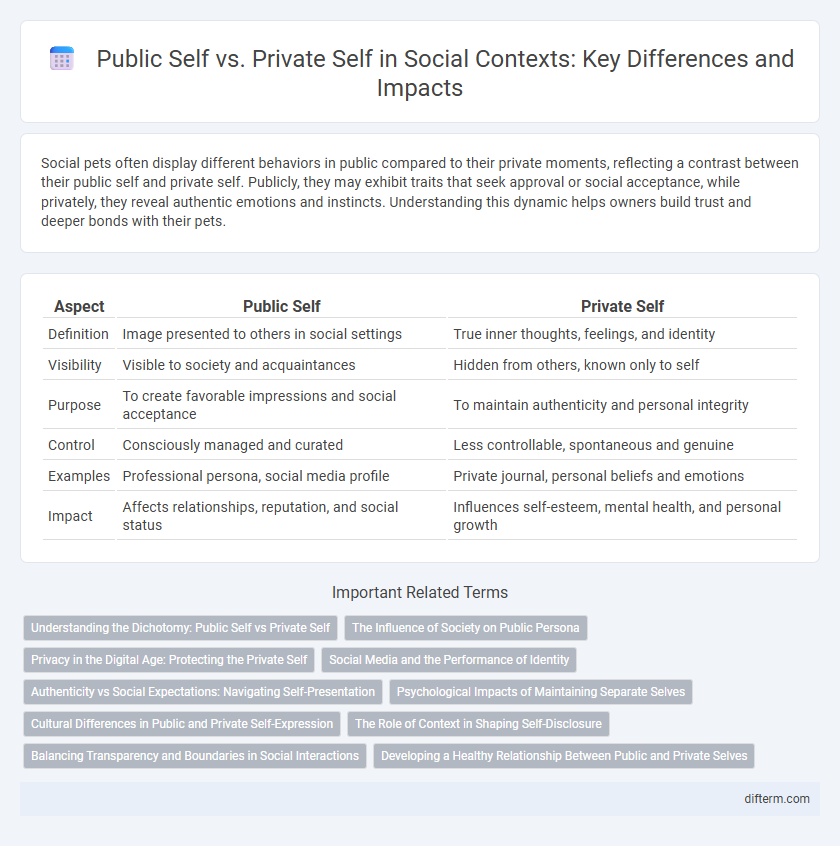Social pets often display different behaviors in public compared to their private moments, reflecting a contrast between their public self and private self. Publicly, they may exhibit traits that seek approval or social acceptance, while privately, they reveal authentic emotions and instincts. Understanding this dynamic helps owners build trust and deeper bonds with their pets.
Table of Comparison
| Aspect | Public Self | Private Self |
|---|---|---|
| Definition | Image presented to others in social settings | True inner thoughts, feelings, and identity |
| Visibility | Visible to society and acquaintances | Hidden from others, known only to self |
| Purpose | To create favorable impressions and social acceptance | To maintain authenticity and personal integrity |
| Control | Consciously managed and curated | Less controllable, spontaneous and genuine |
| Examples | Professional persona, social media profile | Private journal, personal beliefs and emotions |
| Impact | Affects relationships, reputation, and social status | Influences self-esteem, mental health, and personal growth |
Understanding the Dichotomy: Public Self vs Private Self
Understanding the dichotomy between the public self and private self reveals how individuals manage distinct identities based on social context and personal authenticity. The public self often conforms to societal expectations and norms, serving as a curated image for external perception, while the private self embodies genuine thoughts, emotions, and vulnerabilities experienced in intimate settings. This division highlights the psychological tension between social conformity and self-expression, impacting mental health and interpersonal relationships.
The Influence of Society on Public Persona
Society shapes the public persona by imposing expectations and norms that individuals internalize and express through behavior, attire, and communication. Public self-presentation often aligns with cultural values, social roles, and the desire for social acceptance or status. This dynamic interplay between individual identity and societal influence highlights the tension between authentic private self and constructed public self.
Privacy in the Digital Age: Protecting the Private Self
Protecting the private self in the digital age requires rigorous control over personal data shared across social media platforms and online networks. Digital privacy tools such as encryption, two-factor authentication, and privacy settings on devices help safeguard sensitive information from unauthorized access. Awareness of data collection practices by technology companies and proactive management of digital footprints are essential to maintaining boundaries between public self-presentation and private identity.
Social Media and the Performance of Identity
Social media platforms amplify the performance of identity by blurring boundaries between public self and private self, where curated content often showcases idealized versions rather than authentic experiences. Users strategically manage impressions through selective sharing, influencing how others perceive their social status and personal values. This ongoing performance shapes social interactions and impacts psychological well-being by intertwining digital personas with real-life identity construction.
Authenticity vs Social Expectations: Navigating Self-Presentation
Balancing the authentic self with social expectations requires nuanced self-presentation strategies that align personal values with societal norms. Individuals often navigate this tension by selectively revealing aspects of their private self to maintain credibility and foster genuine connections. Embracing authenticity while managing public perception enhances psychological well-being and promotes meaningful social interactions.
Psychological Impacts of Maintaining Separate Selves
Maintaining separate public and private selves can lead to heightened stress and emotional exhaustion due to the constant need for self-regulation and impression management. Psychological research highlights that this fragmentation often exacerbates feelings of inauthenticity and alienation, diminishing overall well-being. Long-term discord between these selves is associated with increased anxiety, depressive symptoms, and reduced life satisfaction.
Cultural Differences in Public and Private Self-Expression
Cultural differences significantly shape public and private self-expression, with collectivist societies emphasizing harmony and group conformity in public settings while allowing more individualistic expression privately. In contrast, individualistic cultures prioritize personal authenticity in both spheres but may still adjust self-presentation based on social context and relationships. Understanding these nuances aids cross-cultural communication and fosters respect for diverse identity negotiations across social environments.
The Role of Context in Shaping Self-Disclosure
Context significantly influences self-disclosure by determining the boundaries between public self and private self. Individuals tailor their sharing based on social setting, perceived audience, and cultural norms, balancing authenticity with social acceptability. This dynamic interaction shapes identity presentation and interpersonal relationships across varying environments.
Balancing Transparency and Boundaries in Social Interactions
Balancing transparency and boundaries in social interactions requires managing the delicate interplay between the public self and the private self to maintain authenticity without compromising personal privacy. Clear communication of limits fosters trust while protecting emotional well-being, enabling individuals to engage genuinely without oversharing sensitive information. Strategic self-disclosure enhances relationships by promoting openness and respect, aligning with social norms and personal comfort levels.
Developing a Healthy Relationship Between Public and Private Selves
Developing a healthy relationship between public and private selves involves balancing authenticity with social expectations, ensuring genuine self-expression while maintaining appropriate boundaries. Recognizing the fluidity between these selves promotes emotional well-being and strengthens interpersonal connections by reducing inner conflict. Effective self-awareness and mindful communication contribute to integrating both dimensions, fostering a cohesive and resilient identity.
public self vs private self Infographic

 difterm.com
difterm.com